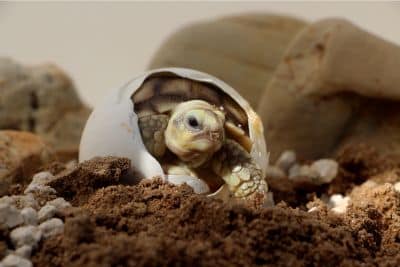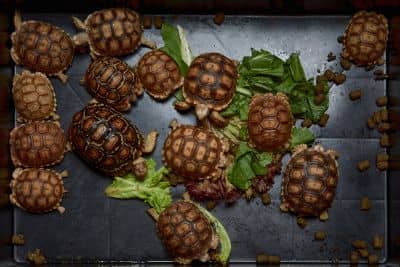Tortoise mating is a fascinating topic that highlights the unique behaviors of these non-marine reptiles.
In this article, I’ll delve into their curious courtship rituals and interesting post-mating practices. So, read on to explore everything you need to know about tortoise romance.
Understanding Tortoise Behavior
Most tortoises will begin the courtship and mating process after hibernation, beginning in early spring and extending through summer.
The courtship behaviors of males are aggressive toward their potential mates. Whilst courtship is often a lengthy process, the actual act of copulation is usually relatively short.
Pre-Mating Behavior
Specific courtship behavior varies between tortoise species, yet they all have one thing in common: aggression. Male tortoises are known for displaying rough and dominant pre-mating behavior.
Typically, a male will bob his head at a female whilst circling her. He will nip and bite at her legs and around the edges of her carapace (shell). This behavior will make the female retreat her head and limbs into her shell. The male can then repeatedly ram into her shell and get her into a position where she can be mounted.
Pre-mating behaviors that can be observed in specific species include:
- Leopard tortoises: This species is known to be particularly aggressive. Males occasionally lift females from the ground when they ram into them.
- Red-footed tortoises: Loud vocalizations such as clucking are produced by males throughout the mating season. These noises serve to attract females and ward off rival males.
- Galapagos tortoises: Males show their interest by following and harassing much smaller females.
Finding a Mate
The cloaca region of both male and female tortoises (the digestive, excretory, and reproductive opening) releases pheromones during the mating season.
These pheromones can be detected by other tortoises, known as scent trailing. By smelling the cloaca region, tortoises can determine the sex and species of a potential mate.
Tortoises are polygamous, meaning they mate with numerous individuals. In the wild, the most dominant and aggressive males will get the most mates.
Generally, male tortoises are not overly picky when choosing a mate. In fact, according to a 2016 study of wild Hermann’s Tortoises, males were observed engaging in same-sex courtship and mating more frequently than females. They also exhibited more extravagant sexual behaviors, including attempting to mount dead tortoises and empty shells. This was referred to in the study as a ‘prison effect’.
Captive Breeding
Being a responsible tortoise keeper means closely observing any captive breeding restrictions in your region.
Assuming you own a tortoise species where breeding is permitted, for two tortoises to be compatible for mating, they must be of the opposite sex, of the same species, and be sexually mature.
You can determine if a tortoise is sexually mature by measuring its shell. Bear in mind that the length will differ depending on the species. For example, a mature Hermann’s tortoise will have a shell length of 7 inches, whereas a mature leopard tortoise will have a shell length of 18 inches.
Due to constant access to food and protection from predators, captive tortoises grow quickly. As a result, it’s not uncommon for them to reach sexual maturity as early as four years of age. On the contrary, wild tortoises grow at a slower pace. On average, wild individuals are not ready to mate until they are between 10 and 20 years old.
Selected partners should also be healthy and disease-free. To encourage mating, keep the pair in a large, comfortable enclosure and away from other tortoises.
Extra consideration is needed when choosing a female tortoise. Generally, elderly females are less fertile compared to younger females. Moreover, females must not be gravid. This means that she has laid all her previous eggs.
Female tortoises can retain sperm for up to 4 years. This means she can lay fertilized eggs, even if she has not mated in a long time.
The Mating Process

The mating process can be rather challenging and intricate for males due to the high domed shell of the female. To counter this, males have evolved a concave plastron to help them balance on top of females during mating.
Following courtship, the male will mount the female. Copulation is a vocal activity, and the male will produce loud grunts and hisses.
He will also vigorously stamp his hind feet. Although copulation is short, a pair may mate several times.
Post-Mating Care
Following copulation, it’s its a question of waiting to see if the female is gravid and if they are ready to lay their eggs. Although there are behavioral cues you can look out for such as loss of appetite and digging, the best way to be certain your female is carrying eggs is to go to the vet for an x-ray.
During this period, I always sprinkle calcium supplements on the female’s food.
Since female tortoises are able to retain sperm for up to 4 years, it’s difficult to know how long an individual’s gestation period will be. In the wild, females generally lay their eggs during spring or summer when the weather is warm and environmental conditions are favorable. For this reason, I recommend you study the natural habitat of your tortoise species, and be sure to replicate those environmental conditions as closely as possible.
To enhance reproductive success, females have developed a unique reproductive anatomy. They can separate fertile eggs into two individual clutches, laying one clutch at a time.
This is an evolutionary trait selected to reduce mortality rates. If the first clutch does not survive, the female has another chance to successfully reproduce as she has avoided ‘putting all her eggs in one basket’.
When it comes to choosing a nest site, there are three primary characteristics that female tortoises look for:
- A sloped area to prevent flooding or water-logging of the nest.
- A location that receives consistent sunlight to ensure the eggs remain at a stable temperature.
- Soil that is firm enough to prevent the nest from collapsing but soft enough to allow the hatchlings to climb out quickly.
Captive, gravid females should be provided with a nest box filled with soil in which they can lay their eggs. The box should be big enough so she can fully turn around inside.
Using her legs, the female will dig a burrow in the soil, in which she will lay her eggs one by one. Typically, a wild tortoise clutch consists of between 4 to 8 eggs.
Conversely, tortoises in captivity have an average clutch size of between 6 and 12 eggs. This is because captive tortoises generally grow larger due to the constant access to food and protection, so can lay more eggs.
After all her eggs have been laid, the female will cover the nest over with soil and urinate on it to drive predators away. In most tortoise species, no parental care is provided to the nest or hatchlings.
The incubation period varies depending on the species of tortoise. For example, Sulcata tortoises have an incubation period of 243 days, whereas Hermann’s tortoises only last 90 days.
For the eggs to develop, they must remain at a certain temperature, which is usually around 84 degrees Fahrenheit.
Like with other reptiles, the nest temperature affects the hatchling sex ratio. Higher temperatures result in more females whereas lower temperatures result in more males.
In the wild, sunlight and moisture will keep the nest at an optimum temperature. In captivity, an incubator (such as the RYFT Incubator for Hatching Eggs) or additional heat source is often needed to ensure the nest temperature remains stable.
Are You Starving Your Tortoise?
Save 10% on premium tortoise food and supplements from Tortoise Resource Center on Amazon now using code BUYNOWGET10

Sulcata Vitamin & Mineral Topper Supplement
30-Day Supply | 2 oz (56 g)
$24.99

Baby Sulcata Tortoise Superfood Powder
30-Day Supply | 2.5 oz (70.8 g) Bag
$24.99
Raising Juveniles
Once they have broken out of their shell using their ‘egg tooth’, hatchlings will climb out of their nest. Not all hatchlings will emerge at the same time.
Although captive hatchlings have a better chance of survival than those in the wild, you’ll need to follow certain care and habitat requirements. As follows:
In terms of habitat, you should keep baby tortoises in a large container filled with sandy soil. You’ll need to set up a heat lamp and UV full spectrum lighting at one end and a cooler, shaded area at the other. Add a variety of items to the enclosure that tortoises can hide under and seek shelter or protection.
Temperatures in the enclosure should mimic those of their natural environment, but as a rule of thumb, you’re looking for a range of 85-95 degrees Fahrenheit in the basking area and 85 degrees Fahrenheit in the cooler section.
Juvenile tortoises can quickly become dehydrated, so in addition to providing a shallow bowl of drinking water, it will require soaking it in a bowl of room-temperature water for 15 to 20 minutes daily.
Older juveniles only need to be soaked 2 or 3 times per week and mature tortoises can be bathed one a week. Make sure the water level is below the tortoise’s chin to avoid drowning.
Every tortoise needs a healthy, herbivorous, varied diet to get all the essential nutrients. Specific dietary needs vary between species, so make sure to follow what is recommended for yours. I like to chop up their greens, grasses and hay really small and offer them as much as they will eat for 20-30 minutes each day.
Finally, you should supplement a juvenile tortoise’s diet with vitamin D and calcium to facilitate healthy growth and development.
Citations
- The Tortoise Protection Group – Gravid Females
- The Tortoise Table – Husbandry advice
- Oxford Academic – Prison effect in wild Hermann’s Tortoises population
- National Library of Medicine – Courtship Behavior


